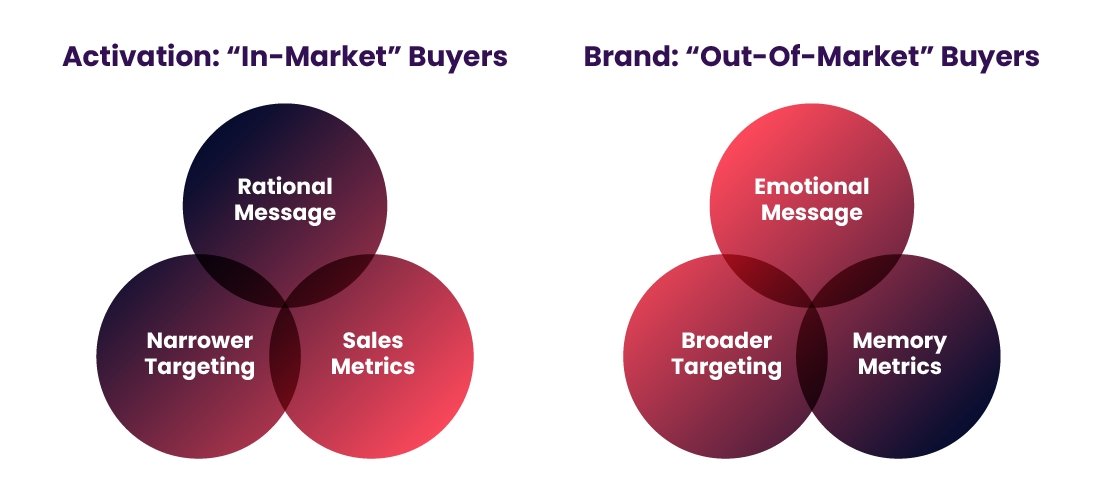Rethinking the B2B buyer journey
With the UK spring budget announcement indicating that the UK is flirting with recession, this report examines it’s potential impact on the B2B buyer journey.
We’ll take a look into channel mix throughout the purchase funnel to understand which channels excel where – and how we can use media mix to our advantage when trying to influence the buyer journey. In order to do this – we must look at decision makers throughout the whole purchase decision process – which for B2B is nowhere near as linear as a standard B2C buying journey.
With the economic climate presenting challenges across sectors, it has never been as integral to invest in tech now to improve efficiencies and keep costs low. The research above from Linkedin shows the B2B buyer attitude to tech investment within their businesses being seen as a key growth driver as well as eventually contributing to cost efficiency.
So what does this group of B2B buyers typically look like?
According to Gartner, a B2B buying group typically consists of six to ten team members, also known as business decision makers (BDMs). As a result of so many members, buying groups and their processes are a key contribution to the longer B2B sales cycle. A benefit of B2B buying groups is that they tend to be responsible for larger deals than those found in B2C meaning ROAS can generally be higher. There are more consequences behind every purchasing decision, this also makes them more valuable – but in turn, more in demand by brands trying to advertise to them.
The B2B sales cycle from receiving traffic/leads can last anything from 6 – 18 months – where vendor selection is often decided by this point.
Source: LinkedIn
So where can we look to influence this cycle to ensure our brands are favoured by the decision makers?
We often hear the funnel being split into 3 key sections – being Awareness, Consideration and Decision stages. By the time a buyer reaches the decision stage it is unlikely that advertising can tangibly make a difference in any purchase decision, so the opportunity lies within the Awareness and Consideration stages.
Buyers typically spend 17% of their time meeting potential suppliers* when they are considering a purchase – so when our audience move into market – we want them primed to select our brand. As 95% of buyers* are typically out-of-market – we must consider this when choosing marketing channels. Programmatic can help establish coverage using hyper-precise targeting tactics– will do some of the priming job whilst buyers do not sit in-market with cost-efficient targeted reach.
Source: 5 Principles of Growth - B2B Institute
Marketers need to balance long and short, brand and activation. Research from the B2B Institute with Binet and Field shows that in B2B, the optimal balance between brand and activation is a 50/50 split: 50% long-term brand, 50% short-term activation.
To appeal to out-of-market buyers, advertisers must utilise broader funnel tactics, making ads memorable & appeal to the emotional side of the buying committee. Whether that is high impact display, or programmatically bought DOOH – we have the ability with buying audience first programmatic to influence this buying committee decision.
Where influence is more complex in B2B compared to B2C – there are elements that remain similar when reaching target audiences. Content should be focussed on pain points to drive demand interest, paired with smart hyper-targeting to ensure we are only speaking to our niche target audience, wherever they are across the web or in connected media environments
“The power of programmatic really is the key to unlocking the B2B buyer journey”
The power of programmatic in the B2B buyer journey
Programmatic can drive results in both the in-market and out-of-market buyer journeys – albeit differently with considerations based on sector.
The complexity of the B2B purchase journey means it is tantamount to work with a specialist marketing partner who understands and considers nuances per sector and audience as not every buying group will act the same. In a time of budgets having to work harder, and the way the industry collects data is changing – the importance of using high quality, non-assumptive data will be key.
Brand building is crucial to success and the influencing of purchase decisions as it is unlikely that buying committees will be influenced by a brand they don’t trust and resonate with.
Programmatic allows consumers to be influenced when they are in premium, contextually relevant environments which in turn can create brand equity. As mentioned earlier in this research – priming our relevant audience, both when they are in and out of- market is key to success for marketing to the B2B buyer. Based on signals from across the web, Encore can ascertain where a user sits in the marketing funnel – and with a combination of tactics – can drive engagement and in turn loyalty with brands.
Tracking, attribution and first party data
Finally, one of the most important considerations for B2B marketers in 2023 will be attributing the effect of their efforts. This is where tracking, attribution and leveraging 1st party data becomes crucial in a year where every marketing pound or dollar spent will come under scrutiny. Investing now in 1st party data – whether within CDP, CRM or customer segmentation – will allow this valuable data to become a marketers most powerful tool in 2023. Using a technology agnostic business such as Encore who have access to powerful exclusive 1st Party data will allow marketers to use smarter data to make smart decisions in 2023 and beyond.



